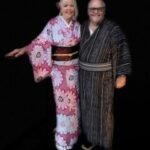 Geiko and Maiko in Kyoto: Japan’s Living Art Form
Geiko and Maiko in Kyoto: Japan’s Living Art Form
In Kyoto’s historic districts of Gion and Miyagawa-cho, geiko and maiko glide gracefully through stone-paved alleys—vibrant kimono, towering okobo sandals, and elaborate hairpieces capturing the attention of passersby.
These women belong to a centuries-old tradition of Japanese performing arts, often misunderstood outside the country.
While the word “geisha” is familiar to many in the West, Kyoto prefers different terms: geiko and maiko. Though they all belong to the same cultural world, the distinctions matter—and they tell a story of art, dedication, and transformation.
What’s the Difference Between Geisha, Geiko, and Maiko?
- Geisha is the general term used throughout Japan for traditional female entertainers trained in classical music, dance, and conversation.
- Geiko is the Kyoto-specific word for a geisha. The kanji literally means “art woman,” just like geisha, but Kyoto has maintained its own unique terminology.
- Maiko translates to “dancing child.” These are apprentice geiko, typically aged 15–20, who train under senior geiko before graduating.
In short: a maiko is an apprentice, and a geiko is a full-fledged professional. Outside of Kyoto, you’d simply call both “geisha.”
A Brief History of the Geisha
The origins of geisha trace back to the 17th century during Japan’s Edo period. Interestingly, the first geisha were men—performers and jesters who entertained guests at social gatherings. It wasn’t until the 1700s that women began to dominate the profession.
Geisha flourished in designated entertainment districts known as hanamachi, providing an elegant, artistic counterpoint to courtesans. Their role was never about romance—it was about art, ambiance, and cultivated companionship.
Kyoto, as Japan’s ancient capital and a bastion of tradition, remains the most prestigious city for geiko and maiko today.
What It Takes to Become a Maiko (and Eventually a Geiko)
Becoming a maiko requires immense commitment. Young women, usually in their mid-teens, move into an okiya (boarding house) in a hanamachi and begin an intensive apprenticeship. Here’s what their path looks like:
- Shikomi (Preparation Stage): The young aspirant lives in the okiya and performs household duties while attending training classes in dance, shamisen (three-stringed instrument), tea ceremony, and etiquette.
- Minarai (Learning by Observation): After mastering the basics, she becomes a minarai—observing older maiko at actual engagements.
- Debut as a Maiko: Once ready, she debuts in public with elaborate attire, distinctive makeup, and a formal hairstyle adorned with seasonal flowers. This stage can last 4–5 years.
- Erikae (Collar Turning): When the maiko reaches full maturity and completes her training (typically around age 20), she ceremonially becomes a geiko. The red-and-white collar of the maiko is replaced by the plain white collar of the geiko.
Geiko Kohatsu plays shamisen while a maiko performs a traditional dance.
Daily Life and Career Span
Maiko and geiko train rigorously in traditional arts and spend their evenings performing at ozashiki (exclusive banquets) where they entertain guests with conversation, dance, and music.
Most retire in their 20s or 30s—some to marry, others to open tea houses or teach. Only a few continue into older age, becoming revered cultural figures.
Debunking the Myths
Hollywood portrayals—especially in Memoirs of a Geisha—have muddied public perception. Contrary to popular misconception, geisha are not courtesans. Their profession is one of cultural preservation and artistic excellence. Geiko and maiko do not date clients, and their work is entirely performance-based.
For a broader historical overview, see this Encyclopedia Britannica article on geisha.
Seeing Geiko and Maiko Today
Kyoto remains the heart of geiko culture, particularly in the hanamachi of:
- Gion Kobu
- Miyagawa-cho
- Ponto-cho
- Kamishichiken
- Gion Higashi
While private ozashiki experiences are invitation-only, public performances like the Miyako Odori (held every April) give visitors a rare glimpse into this elegant world. You may also see maiko walking to engagements in the early evening—though tourists are urged to admire respectfully and avoid interfering.
Final Thoughts
To watch a maiko dance or listen to a geiko play shamisen is to witness a living thread of Japanese cultural history. These women embody grace, discipline, and devotion to their craft. In a rapidly modernizing world, the hanamachi of Kyoto continue to preserve a delicate and beautiful tradition—one that invites admiration, not misunderstanding.
For more information or to book a Japan cultural journey or cruise, please call Roaming Boomers Travel Services at (480) 550-1235 or use our convenient online information request (click here) and we’ll reach out to you.
If you enjoyed this article, sign up for our travel newsletter to keep abreast of our best travel tips, on-location reviews, exclusive travel offers, group travel events, and much more.

This article was written with the aid of Perplexity AI, Grok, or ChatGPT. Roaming Boomers Travel Services is an independent affiliate of Cadence and a Virtuoso® member. CST#201120-40
The post Geiko and Maiko in Kyoto: Japan’s Living Art Form appeared first on The Roaming Boomers













